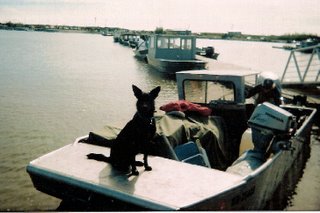Really Bad Eczema
Remember the old TV ad with the sonorous voice-over that said “Eczema…seborrhea…the heartbreak of psoriasis…” ? I don’t remember now what product the ad was selling, I just remember the phrase. Many Yupik Eskimos of southwest Alaska could be posterchildren for that ad. I have never seen such severe atopic skin disease as I have encountered here.
Recently I spoke with one of the pediatricians on the medical staff of our hospital who has a special interest in the “triple A triad”: atopy, allergy and asthma. He considers our pediatric population to be “hyperreactive”—they have more hives, more rashes, more rhinitis, more wheezing than non-Native children in the lower 48 or in Alaska.
.
 Eczema is an extremely common problem among the children here, and it is often severe. Occasionally I see a child in whom it is limited to wrists or elbow creases, or perhaps around the ears; more commonly it is far more wide spread, sometimes involving the entire body.
Eczema is an extremely common problem among the children here, and it is often severe. Occasionally I see a child in whom it is limited to wrists or elbow creases, or perhaps around the ears; more commonly it is far more wide spread, sometimes involving the entire body.The child in these photos is Joshua, a 4-year-old boy from one of the villages. His photos are used with his mother’s permission. His hospital record contains his entire medical history from birth on. He had no skin problems at all until the age of 2, when he was noted on Well Child Exam to have small areas of eczema at the elbow creases. His mom was given hydrocortisone cream for the rash.
.

Over the next year he was found to have ever-increasing areas of eczema, more dry skin, more itching misery. Mom was given diphenhydramine suspension (Benedryl) to help with his itching and moisturizers to treat his dry skin. It is unclear how regularly these have been used; often, months have gone by with no refills being obtained.
At this point, his entire body is covered in a severe case of eczema, with constant itching, flaking and peeling skin, and frequent skin infections (impetigo) from the open sores he has scratched into being. He has gone from a laughing, happy boy at age 2 to a somewhat grumpy and petulant child with a scowl much of the time. And with good reason; how miserable can it be to have skin like this? It breaks my heart to see what he lives with every day.
.
.

He is periodically treated with oral steroids when the eczema is at its worst. He is regularly given topical steroids: mid-potency creams like triamcinolone for the body and low-potency creams like hydrocortisone for the face. And lots of moisturizers such as Aqua-Phor and Eucerin for constant treatment of his dry skin.
I always wonder about medication compliance; Joshua has five siblings, and two of them have similar, though less severe problems. His mom tries her best with all of them, but Joshua’s skin care may be somewhat sporatic.
Joshua’s case is one of the more severe, but it is by no means rare. Nearly every village has a child or two with eczema this bad, and many children with less severe conditions. They often improve significantly by age 6 or 7 and may have minimal problem with it after that.

Fortunately, Joshua has not had the co-existing problems with asthma, allergies, and ear infections that many atopic children do. The ones who get all three of the Triple A Triad have a huge ration of misery to deal with in childhood. I wonder to what degree that experience affects their outlook as adults. Are they generally more cranky and/or whiney? More pessimistic? More complaining? More dissatisfied with life? I would think that possibility would be there, but I don’t see it in my adult patients who tell me they had “bad eczema as a child.”
I am optimistic that Joshua’s personality will not be molded by his skin’s discomfort. Despite his constant itching, he plays with other children, has outbursts of joy, and is sometimes quite charming. I hope he is one of the lucky ones whose skin will clear in the next few years and allow him some peace.
Labels: Bush Medicine





































